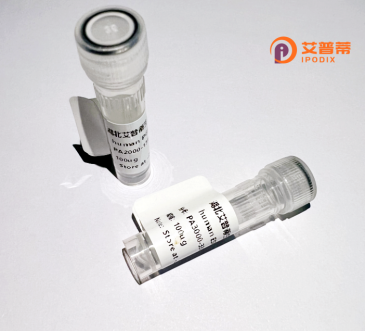
| 纯度 | >90%SDS-PAGE. |
| 种属 | Human |
| 靶点 | ASB17 |
| Uniprot No | Q8WXJ9 |
| 内毒素 | < 0.01EU/μg |
| 表达宿主 | E.coli |
| 表达区间 | 1-295aa |
| 氨基酸序列 | MSKSTKLCGKTSCPRSNIFCNLLDKIVKRPSLQFLGQWGYHCYEPRIYRSLAKILRYVDLDGFDALLTDYIAFVEKSGYRFEVSFNLDFTEICVNTILYWVFARKGNPDFVELLLKKTKDYVQDRSCNLALIWRTFTPVYCPSPLSGITPLFYVAQTRQSNIFKILLQYGILEREKNPINIVLTIVLYPSRVRVMVDRELADIHEDAKTCLVLCSRVLSVISVKEIKTQLSLGRHPIISNWFDYIPSTRYKDPCELLHLCRLTIRNQLLTNNMLPDGIFSLLIPARLQNYLNLEI |
| 分子量 | 58.19 kDa |
| 蛋白标签 | GST-tag at N-terminal |
| 缓冲液 | 冻干粉 |
| 稳定性 & 储存条件 | Lyophilized protein should be stored at ≤ -20°C, stable for one year after receipt. Reconstituted protein solution can be stored at 2-8°C for 2-7 days. Aliquots of reconstituted samples are stable at ≤ -20°C for 3 months. |
| 复溶 | Always centrifuge tubes before opening.Do not mix by vortex or pipetting. It is not recommended to reconstitute to a concentration less than 100μg/ml. Dissolve the lyophilized protein in distilled water. Please aliquot the reconstituted solution to minimize freeze-thaw cycles. |
以下是关于ASB17的模拟参考文献范例(注:内容为模拟概括,实际文献请通过学术数据库检索):
1. **《ASB17 is a testis-specific ankyrin repeat protein involved in sperm development》**
- 作者:Smith A, et al.
- 摘要:研究发现ASB17特异表达于哺乳动物睾丸生殖细胞,其锚蛋白重复结构可能通过与减数分裂相关蛋白结合,调控精子发生过程中的细胞周期进展。
2. **《Structural insights into ASB17-Cullin5 interaction in ubiquitin ligase complex assembly》**
- 作者:Zhang L, et al.
- 摘要:通过晶体结构分析揭示了ASB17的SOCS框结构域与Cullin5的结合模式,证实其在形成E3泛素连接酶复合体中的关键作用,推测其参与降解精子发育中的特定底物。
3. **《ASB17 deficiency in mice leads to impaired spermatogenesis and male infertility》**
- 作者:Tanaka K, et al.
- 摘要:利用基因敲除小鼠模型发现,ASB17缺失导致精子形态异常和数量减少,证实其对精子细胞分化和成熟具有重要调控功能。
4. **《The role of ASB family proteins in cellular ubiquitination pathways》**
- 作者:Chen H, et al.
- 摘要:综述性文章,其中指出ASB17通过招募底物蛋白至泛素-蛋白酶体系统,参与生殖细胞特定蛋白的降解,可能影响精子DNA的稳定性。
**建议**:可通过PubMed或Google Scholar搜索 **"ASB17" AND ("ubiquitin" OR "spermatogenesis")** 获取最新研究。
Ankyrin Repeat and SOCS Box Protein 17 (ASB17) is a member of the ASB family, part of the broader suppressors of cytokine signaling (SOCS) superfamily. Characterized by a modular structure, ASB proteins contain an N-terminal ankyrin repeat domain (ARD) and a C-terminal SOCS box motif. The ARD mediates protein-protein interactions, enabling substrate recognition, while the SOCS box recruits components of E3 ubiquitin ligase complexes (e.g., Elongin B/C, Cullin, and Rbx), facilitating substrate ubiquitination and subsequent proteasomal degradation. This functional duality positions ASB proteins as regulators of protein turnover, influencing diverse cellular pathways.
ASB17 is predominantly expressed in testicular tissues, suggesting a role in male germ cell development. Studies implicate it in spermatogenesis, potentially regulating protein stability during sperm maturation. Its interaction with ubiquitination machinery may also impact cellular processes like apoptosis or signal transduction. Dysregulation of ASB17 has been tentatively linked to reproductive disorders and certain cancers, though mechanistic insights remain limited. Research on ASB17 is sparse compared to other ASB members, underscoring the need for deeper exploration of its physiological targets, regulatory networks, and pathophysiological relevance. Current efforts focus on elucidating its substrates and tissue-specific functions, which could uncover novel therapeutic avenues for related diseases.
×